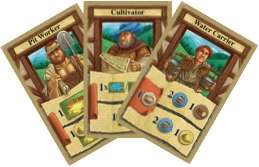
Play according to the rules of the 2-player game but with the following changes.
The goal of the solo game is to have as many points as possible at the end of the 7th building period. (30 points is considered a remarkable score).
For each building period, choose a number of Specialist cards as indicated by the following table. Set the other cards aside, face-down.


Shuffle the chosen Specialist cards and draw one randomly.
Play this card using only one of the two abilities on it. Continue to do so until you have only two cards left in your hand.
Look at these cards and pick one of them. Play this card using both of its abilities and ignore the other card.
At the end of every building period, set the chosen cards aside (including the unused one), face-up and fanned out. You cannot choose from these cards in the following building period.
Then take the cards that you had not chosen as well as the fanned out cards from the previous building period and choose a new set of cards - according to the table on the previous page - for the next building period.

Example: Your choice for the first building period includes the Pit Worker, Cultivator and Water Carrier. You shuffle these cards and draw one of them randomly: the Pit Worker.
You use one of its abilities. Between the remaining two cards, you decide to play the Cultivator. You may use both of its abilities. The Water Carrier remains unused.
For the second building period, you cannot choose the Pit Worker, Cultivator or Water Carrier again since you had to set them aside, fanned out. You will be able to choose from them again in the third building period.
Details
In the solo game, the first ability of the Supplier only provides a single basic good of your choice instead of two goods.
You do not need to keep track of what building period you are in. Just look at the number of fanned-out cards. (This is due to the fact that you will use a different number of cards in consecutive building periods, see table). Therefore, you do not need to count the seven building periods.
Continue Reading

